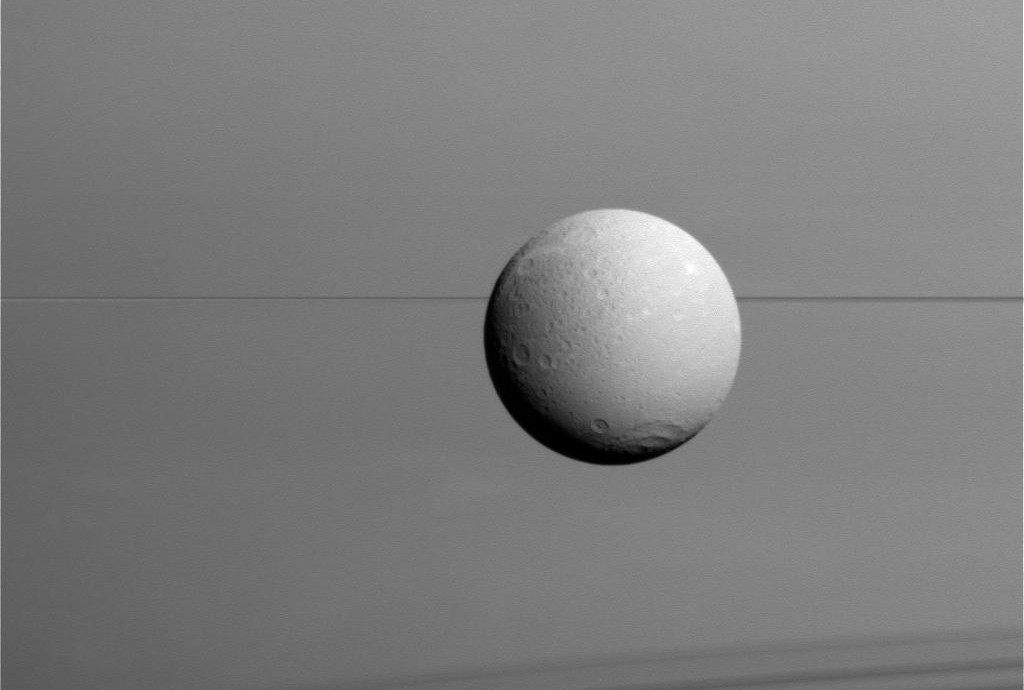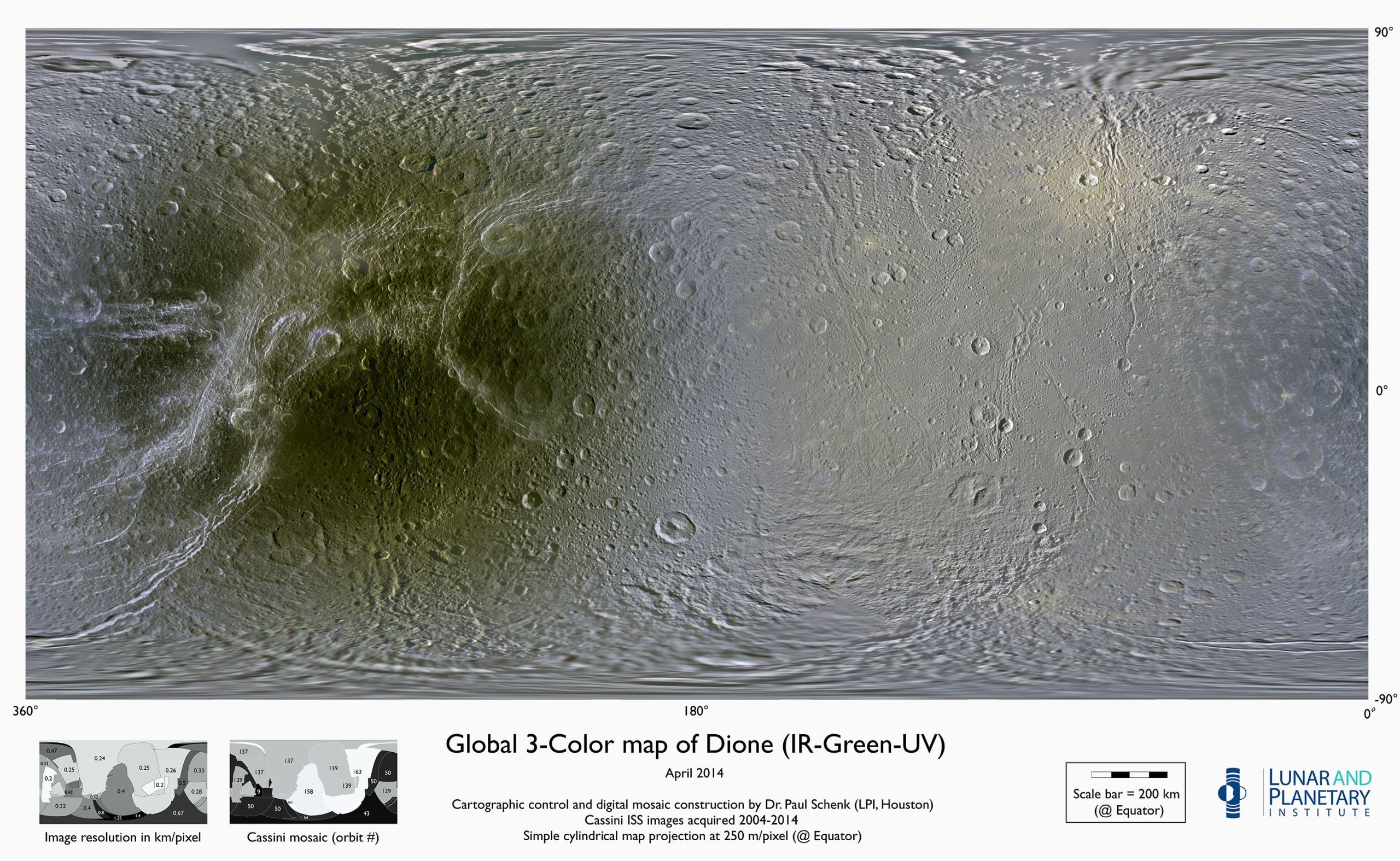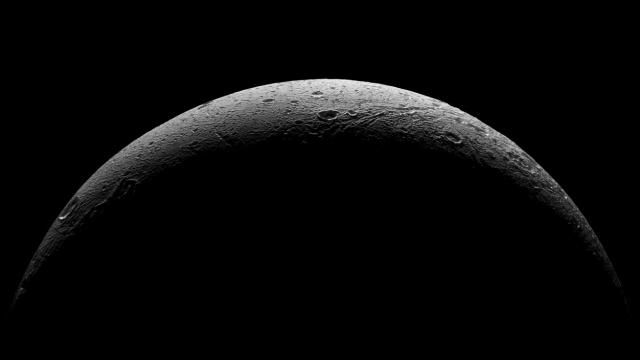The evidence is mounting that our solar system is rife with oceans. Last week, scientists reported that Pluto could have an insanely deep liquid water swimming pool beneath its surface, and this week, NASA revealed new evidence for geyser activity on icy Europa. Now, another frozen moon is poised to join the club of outer space scuba retreats: Dione.
A parting view of Saturn’s moon Dione from Cassini’s final flyby on 17 April 2015. Image: NASA/JPL-Caltech/Space Science Institute
The fourth largest moon of Saturn, Dione was first imaged by the Voyager space probes in the 1980s, and has been viewed more recently by the Cassini spacecraft, during a series of five close flybys. It’s a beautiful, cratered ball of ice and rock, home to deep canyons and towering cliffs. While early flybys offered hints of geologic activity, there’s never been a smoking gun to prove Dione is alive inside — particularly when compared with its next-door neighbour (and orbital resonance partner) Enceladus, which is spewing seawater out of enormous geysers.

Dione against a backdrop of Saturn’s rings. Image: NASA/JPL-Caltech/Space Science Institute
But a new study, which has been accepted for publication in Geophysical Research Letters, suggests that we may have underestimated Dione. The moon could have a liquid water ocean beneath its surface, just like Enceladus. Using a geophysical model that depicts a crust “floating” atop a mantle, Mikael Beuthe of the Royal Observatory of Belgium shows that gravity data collected by Cassini can be explained by an approximately 100km-thick shell of ice enveloping a 65km-deep ocean. Dione’s ocean, in turn, would smother a rocky core.
The first evidence for a subsurface ocean on Enceladus also came from gravity anomalies detected by Cassini, in a series of flybys between 2010 and 2012. As the spacecraft zipped past the moon, its velocity was slightly altered due to variations in Enceladus’ gravitational field. That change in velocity was measured from Earth via the Doppler effect — a shift in the radio frequency of Cassini’s transmissions.
In 2014, researchers at the Jet Propulsion Laboratory concluded that Cassini’s radio transmissions were hinting at a south polar sea beneath Enceladus’ icy shell. But a year later, independent measurements of Enceladus’ “libration” — a slight wobble as it orbits Saturn — revealed that the ocean is probably global.
“For Dione, we did a similar gravity-topography analysis as was done for Enceladus in 2014, but with improved techniques,” Beuthe told Gizmodo. “Thus that’s the best evidence we have now for a present-day ocean on Dione.”

Colour map of Dione’s surface, showing ice cliffs and patches of smooth terrain that indicate recent geologic resurfacing. Image: Wikimedia
According to Beuthe, we won’t be able to confirm Dione’s ocean with libration measurements the way we did for Enceladus, both because Dione is more spherical and because its crust is thicker. But there are other reasons to suspect this moon’s ocean is the real deal.
For one, gravity data also tells us Dione has a rocky core, spanning approximately 70 per cent of its total radius. As radioactive elements decay within the core, they produce heat, melting the overlying ice. This almost certainly caused a subsurface ocean to form in Dione’s early history — which, by the way, might not have been too long ago.
“We don’t yet know whether the ocean froze or not afterwards,” Beuthe said. “But freezing would cause global expansion which should be seen in a certain type of cracks [which have] not been observed on the surface.”
Icy cliffs and smooth terrains also hint at recent geologic activity, which again, is difficult to explain if Dione is simply a ball of ice frozen to rock. Detection of geysers, similar to those seen on Enceladus and Europa, would really seal the deal for an ocean on Dione. But we haven’t seen geysers yet, and given the estimated thickness of Dione’s crust, Beuthe isn’t so sure we will.
To confirm the ocean, he says, “we need a new mission, which won’t happen for a long time.”
If Beuthe’s hunch about Dione is correct, the astrobiology implications are thrilling. It’s likely the ocean would have been around for the moon’s entire existence, long enough for microbial life to emerge under the right conditions. Another mind boggling thought: Perhaps Dione and Enceladus have been exchanging alien microbes for hundreds of millions of years.
If one thing is becoming clear, it’s that oceans are not so unusual or special in our cosmic backyard. Does that mean life isn’t, either? We’ll need to keep exploring to find out.
